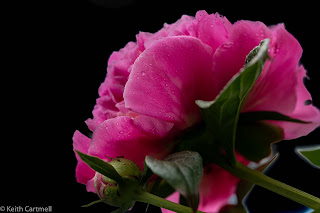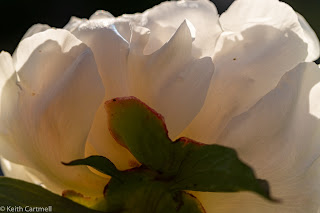No, the book isn't about chocolate or other sweets. As you can see from the title it's about photography. But it's still sweet.
Why? This gets into my theory on expertise. At one end of the scale are people who know nothing on a topic (and it's beside the current point if they know that or not) and on the other end of the scale are people that know everything about a topic, which might be really specific, or it might include related topics or the history of expertise on that topic. The source of that expertise probably isn't relevant, but probably includes formal or informal education and real experience in the world of hard knocks. "Internet research" plays essentially no role in such expertise.
There are many books that cater to people that know little or nothing on a topic. The 'Topic X for Dummies' series is only one example. I freely admit there is a place for such books, and a wide, very very wide market for them. There are a great many people that know far less than they should on a great many topics. (Don't get me started!)
The authors of such books might be almost anywhere on the scale of expertise. What they really need to know is how to write clearly so as to present the topic in an orderly and understandable fashion. This is actually more difficult than one might think, but that doesn't slow down many writers of such books.
At the opposite end of the scale are weighty tomes written by experts in the topic, with an audience that is typically for other experts (I sometimes think to score points against them), or people that are nearly experts. These books are typically extremely detailed, with notes about exactly what circumstances the topic might or might not apply. They typically assume a strong background in the topic at hand.
It's the space between those extremes that is difficult to fill. The writer actually needs some level of expertise in addition to writing skill. They need to be able to place their text into the context of the overall topic, building a skillful transition at the beginning so people know where they are. Often such books have a clear table of contents and perhaps even (gasp!) an index. There might even be a statement of what the book is not, which can be a handy thing.
Which, as an aside, is why I dislike videos so much. I can scrub through a book or block of text while thinking, I know that, I know that, yes I'd forgotten that but good to be reminded, oh what I knew there has been updated, oops I'd not realized that was applicable, and aha, I did not know that. One cannot do that in a video. Sometimes one wants a list of tools and materials, or a step by step process, or maybe diagrams or photographs. Sometimes when you have that, the right video can be good.
The book at hand hits that sweet spot. It assumes you know photography basics such as the essential relationship between f stops, ISO, and shutter speed, and gets into the application of that knowledge to go from a good photograph to a much better one. He compares a shots done by a student, and done by him. Sometimes it's a before and after by a student. Or more precisely, after basic instruction, but before explicit and detailed application of those instructions for this particular shot, and then the photo after the detailed instruction. There is much that is good to point out how a so-so shot can turn into a really good shot with some subtle changes.
Often the detailed instruction is to get closer to the subject, but occasionally (rarely) to get further away. There are a many situations where the interplay of light and shadow on a subject will fool a camera or the photographer into using the wrong settings. Usually the ordinary settings will result in an ok but ordinary photograph. One that follows the rules. A there I was and this is what I saw kind of shot. A dramatic story telling photo will often bend or break the rules in a certain way, which typically does not happen by accident.
Peterson has been a photographer for a long time, bridging between the film and digital worlds. In the film world you typically don't get the luxury of many shots. The photographer has to figure out what the subject is, why they are taking the photo, and what settings will deliver the desired results. The better the shot was on film, the easier developing and creating a print will be. That followed him into the digital world, where it's more than easily possible to take hundreds of photos in a few minutes. That inevitably leads to sorting through hundreds of images in software, and trying to find the best one, or the one you can fix with the tools and skills on hand. His thinking is that if you get the shot as right as possible in camera, there is less software work.
I'm trying to apply that thinking, and it's a bit tricky. Trying to bridge the gap between not knowing how to use a camera to getting ordinary photos is a bit of a learning curve, but mainly just requires a bit of coaching and lots of practice. Trying to bridge the gap between reliably getting ordinary and sometimes good photos, to creating extraordinary photos is difficult. In some senses the process used to learn to get ordinary shots will start to work against you.
An extraordinary photo is typically not the result of a rushed shot. The photographer has to learn to see the ordinary shot, and then understand what can be done to change that to extraordinary. It could be anything from moving the camera a tiny bit or maybe a lot. It could be tweaking the settings. It could be putting a filter of some kind on the lens. Maybe changing something about the subject or their placement.
And maybe, just maybe, realizing there isn't a shot there at all. Sometimes it's a pig, and no amount of lipstick can change that. So unless that's your subject for some reason (perhaps you're the photographer assigned to the local agricultural fall fair and you know the editor has a thing about pigs) you move on.
About the only thing I didn't like was his habit of using a weird filter to colour the skies magenta on skyline photos. I don't agree with that, but each to their own.
There are some techniques he suggests that I want to try.
Try the long exposure zoom adjust shot on anything with light in it. Skyline, reflections, not just fireworks. Like this. I specifically set up for this shot, using a tripod and neutral density filter, and playing with exposure settings.
Flash during the day to light up a flower, but turn the background dark. I'd never thought of this. I know some people like to put a black paper behind the subject flower. When I originally edited this shot the background was pure white. Using the new sky tools in Lightroom I was able to recover a bit of detail in the clouds, but it didn't change the photo in any significant way.
More advice.
Don't be afraid to overexpose snowy scenes a bit to get the snow white. I struggle with gray or blue snow, so I'll be trying this. Guess what, there's snow outside!
For wide angle shots, go to high f stop, and manually focus to about 1 m in front of the camera. Everything from about half that out to infinity will be in focus in the shot. Place the subject accordingly. Don't worry if it looks out of focus in the viewfinder, once the lens is stopped down it will be fine. Check with the depth of field button if necessary. He doesn't tell you how to do any of this, since it will be different for each camera and lens.
Learn to play with white balance in camera. I started doing this during the last night trip. I typically leave it on AWB, but have been branching out.
Learn to see line, texture, and colour, everywhere! This is a life long journey for a photographer.
Double exposures! I've been wanting to do these in camera for a while, so I think this will be one of my winter projects.
Note that Peterson typically doesn't give instructions on how to manipulate your camera settings. There's some detail around the interplay of flash settings and camera settings, which I thought appropriate. That isn't basic photographer knowledge.
I got the book out of the library, and might well get it out again. If I saw it on sale I might just buy it. Higher praise than that I cannot say for a book.
Of the Day
Driftwood and a serendipity from the garden earlier this year.
Lily
Eagle











No comments:
Post a Comment
Looking forward to reading your comment!